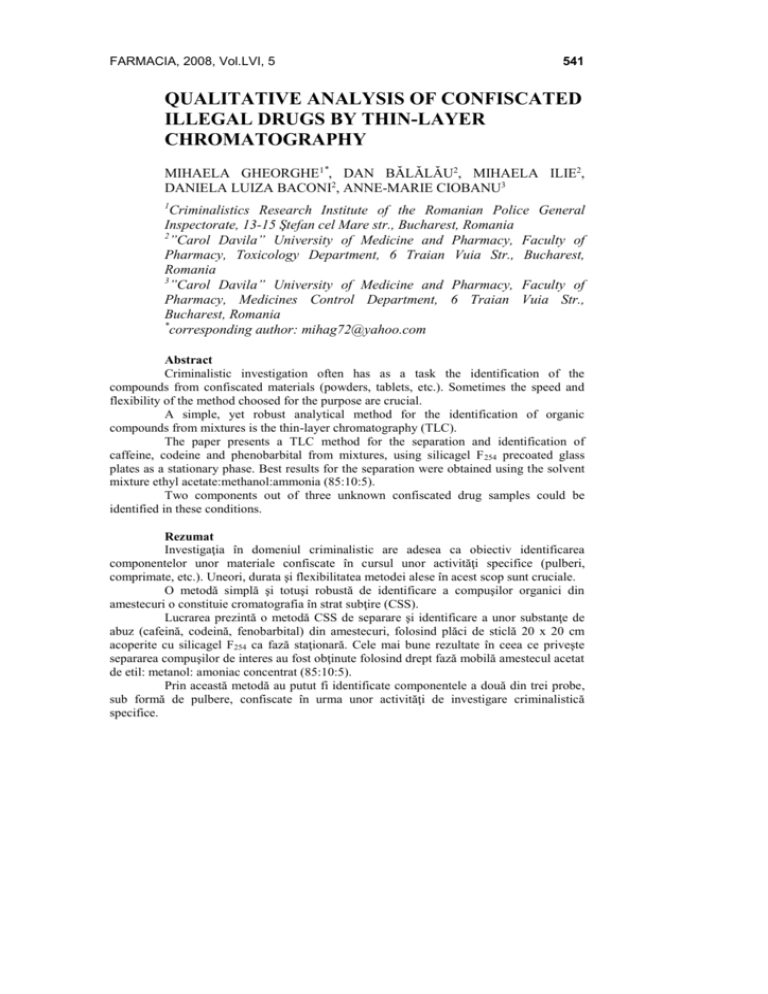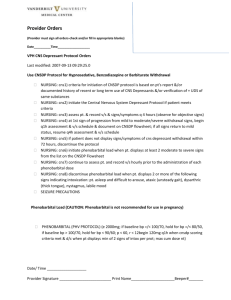qualitative analysis of confiscated illegal drugs by
advertisement

FARMACIA, 2008, Vol.LVI, 5 541 QUALITATIVE ANALYSIS OF CONFISCATED ILLEGAL DRUGS BY THIN-LAYER CHROMATOGRAPHY MIHAELA GHEORGHE1*, DAN BĂLĂLĂU2, MIHAELA ILIE2, DANIELA LUIZA BACONI2, ANNE-MARIE CIOBANU3 1 Criminalistics Research Institute of the Romanian Police General Inspectorate, 13-15 Ştefan cel Mare str., Bucharest, Romania 2 ”Carol Davila” University of Medicine and Pharmacy, Faculty of Pharmacy, Toxicology Department, 6 Traian Vuia Str., Bucharest, Romania 3 ”Carol Davila” University of Medicine and Pharmacy, Faculty of Pharmacy, Medicines Control Department, 6 Traian Vuia Str., Bucharest, Romania * corresponding author: mihag72@yahoo.com Abstract Criminalistic investigation often has as a task the identification of the compounds from confiscated materials (powders, tablets, etc.). Sometimes the speed and flexibility of the method choosed for the purpose are crucial. A simple, yet robust analytical method for the identification of organic compounds from mixtures is the thin-layer chromatography (TLC). The paper presents a TLC method for the separation and identification of caffeine, codeine and phenobarbital from mixtures, using silicagel F 254 precoated glass plates as a stationary phase. Best results for the separation were obtained using the solvent mixture ethyl acetate:methanol:ammonia (85:10:5). Two components out of three unknown confiscated drug samples could be identified in these conditions. Rezumat Investigaţia în domeniul criminalistic are adesea ca obiectiv identificarea componentelor unor materiale confiscate în cursul unor activităţi specifice (pulberi, comprimate, etc.). Uneori, durata şi flexibilitatea metodei alese în acest scop sunt cruciale. O metodă simplă şi totuşi robustă de identificare a compuşilor organici din amestecuri o constituie cromatografia în strat subţire (CSS). Lucrarea prezintă o metodă CSS de separare şi identificare a unor substanţe de abuz (cafeină, codeină, fenobarbital) din amestecuri, folosind plăci de sticlă 20 x 20 cm acoperite cu silicagel F254 ca fază staţionară. Cele mai bune rezultate în ceea ce priveşte separarea compuşilor de interes au fost obţinute folosind drept fază mobilă amestecul acetat de etil: metanol: amoniac concentrat (85:10:5). Prin această metodă au putut fi identificate componentele a două din trei probe, sub formă de pulbere, confiscate în urma unor activităţi de investigare criminalistică specifice. 542 FARMACIA, 2008, Vol.LVI, 5 illegal drugs codeine caffeine phenobarbital heroin thin-layer chromatography INTRODUCTION Delict body analysis represents an important field of research in criminalistics. A specific direction in this regard is the qualitative analysis of confiscated drug samples, which frequently contain mixtures of different psychoactive compounds, including substances that are under legal control [1]. Often, samples of illegal drugs are adulterated (e.g. heroin contains caffein and phenobarbital as most used adulterants, codeine contains also acetylcodeine and noscapine, which are impurities of the production process, etc.), and identification of the components can give information on the drug origin. A simple, rather inexpensive and still robust separation and identification method for the components of such mixtures is the thin-layer chromatography (TLC). Even less precise than other instrumental methods, such as immunoanalysis, high performance liquid chromatography (HPLC) or gas-chromatography – mass spectrometry (GC-MS), TLC finds its place among the criminalistic investigation methods [2, 3]. TLC methods have been sucessfully applied to identify caffeine, codeine and phenobarbital from a mixture [3], opium, morphine, codeine, thebaine, papaverine, noscapine, ethylmorphyne, heroine, buprenorphine, dextromethorphan and methadone from a sinthetic mixture [4], codeine, dihidrocodeine, hydrocodeone and hydromorphone [5], and also as a screening test for morphine, codeine, quinine, methadone and norpropoxiphene from the urine samples of addicted subjects [6]. The paper presents the results obtained for the identification of three confiscated drug samples in an attempt to establish a method for the best separation of the compounds that can be found in illegal drugs. MATERIALS AND METHODS - Substances: caffeine (CF), from Janssen Chemica, 1 mg/mL in chloroform; codeine phosphate (C), from Janssen Chemica, 1 mg/mL in methanol HPLC grade (Sigma); natrium phenobarbital (F), from Fluka, 1 mg/mL in methanol HPLC grade (Sigma); FARMACIA, 2008, Vol.LVI, 5 543 - three confiscated illicit drug samples, noted as X, Y, Z, solubilised in methanol HPLC grade (Sigma) Stationary phase: - precoated silicagel glass plates, 60 F254, 20 x 20 cm, from Merck Solvents and substances for mobile phases: - methanol (HPLC, Sigma); - ethyl acetate (p.a., Chimopar S.A.); - ammonia 25% (Chimactiv S.A.); - chloroform (Chimopar S.A.); - n-buthanol (Merck); - NaBr (Chimopar S.A.). Devices - varipette, 2 – 20 µL; - developing tank; - computer assisted aquisition and image processing system (Vilber Lourmat), consisting in dark chamber, UV lamps, monochrom video camera, BioCapt software. Procedure We spotted aliquots of 2 to 15 μL of known stock solutions in parallel with the samples (X, Y, Z). The plates were developped with the mobile phase in a developping vertical tank. When the mobile phase front reached about 1 cm the plate edge, the plates were extracted from the tank and let still at dark for the evaporation of the residual mobile phase. The examination of the plates was further performed using UV irradiation at λ=254 nm, the image of the plate was captured with the video camera and interpreted with the BioProfil ver. 2.0 software. Analysis The separation results were expressed as Rf values, according to the equation (1): l compound (1) Rf l solvent where Icompound represents the migration distance of the compound from the origin, and Isolvent represents the migration distance of the front solvent from the origin [3]. RESULTS AND DISCUSSION For the identification of caffeine, codeine and phenobarbital from a mixture we tested six solvent systems (Table I). The results suggest that best 544 FARMACIA, 2008, Vol.LVI, 5 separation results are obtained with systems 5 and 6 (figures 1 and 2), the Rf values being definitely different. Table I Results obtained for the TLC separation of caffeine, codeine and phenobarbital from mixtures System Mobile phase1 Rf values CF C F X Y Z 0.47 0.78 0 0.75 0.59 Methanol: 25% ammonia S1 0.78 0.47 0.99 (100:1.5) 0.99 0.88 0.99 0.98 0.35 0.91 0 0.91 0.37 Chloroform: methanol S2 0.90 0.30 0.87 (90:10) 1 0.64 1 1 0.22 0.58 0 0.58 0.22 Methanol: n-buthanol S3 0.45 0.18 0.92 0.25 (15:10) + 0.1 M NaBr 0.95 0.95 0.81 0.91 0.03 0.25 0 0.26 0.10 0.11 S4 Ethyl acetate 0.29 0.03 1 1 0.52 1 0.72 1 0.25 0.32 0.71 0.71 0.83 S5 Methanol 0.71 0.21 0.96 0.14 0.96 0.96 0.96 0.28 0.59 0.15 0.56 0.70 0.53 Ethyl acetate:methanol: S6 0.69 0.27 0.58 25% ammonia (85:10:5) 0.90 0.67 0.96 0.96 1 All mixtures of solvents are expressed as parts, v/v. The identification of the compounds was possible only for samples X (caffeine, codeine and phenobarbital) and Y (caffeine and phenobarbital); in both samples a small spot which migrates with the solvent front could not be identified with any of the standard substances tested. Similarily, the composition of the Z sample remained unknown after several tests performed with substances of abuse. 545 FARMACIA, 2008, Vol.LVI, 5 A polar solvent (methanol – S5) results in greater Rf values for weak acid substances (phenobarbital) and smaller Rf values for weak alkaline substances (such as codeine). The increase of the pH of the mobile phase with 25% ammonia results in an increase in the migration distance (hence the Rf value) for codeine, but has no major influence on phaenobarbital. The decrease in the developant polarity (S1 compared to S6) by adding ethyl acetate reduces the migration distance for phenobarbital. We could conclude that a mixture between a polar solvent (methanol) and a mild polar solvent (ethyl acetate) ensures the optimum separation between the three tested drugs. CF C F X Y Z Figure 1 TLC chromatogram obtained with system 5 (CF=5µg, C=5µg, F=10µg, M1=4µgCF+8µgC+10µgF) M1 CF C F X Y Z M2 Figure 2 LC chromatogram obtained with system 6 (CF=5µg, C=5µg, F=10µg, M2=6µgCF+6µgC+12µgF) CONCLUSIONS Thin-layer chromatography is a simple and robust method that can be used to identify the compounds from confiscated illegal drugs. 546 FARMACIA, 2008, Vol.LVI, 5 Our results confirm the possibility of a rapid identification of three substances of abuse (caffeine, codeine and phenobarbital) from mixtures, using TLC method. The stationary phase used was silicagel F254 precoated glass plates, 20 x 20 cm. From the mobile phases tested, best results were obtained with a mixture of a mild polar and a polar solvent, alkalinised with 25% ammonia (ethyl acetate:methanol: 25% ammonia, 85:10:5, v/v). The examination of the plates was performed using 254 nm UV light. The aquisition and the interpretation of the chromatograms was computer assisted, using a video camera and a specialised image processsor. The analysis of three confiscated drug samples resulted in the identification of codeine, caffeine and phenobarbital in sample noted as X, caffeine and phenobarbital in the sample noted as Y. The compounds of the sample noted as Z could not be identified through this method, suggesting that in certain cases another method should be used (e.g. GC-MS). REFERENCES 1. Baconi D., Toxicomanii, note de curs, Editura Tehnoplast Company S.R.L., Bucureşti, 2005, 27-35, 79-96 2. Jork H., Funk W., Fischer W., Wimmer H., Thin-Layer Chromatography, Reagents and Detection Methods, 1990, VCH Publishers, 3-10 3. *** Clarke’s Analysis of Drugs and Poisons in Pharmaceuticals, Body Fluids and Postmortem Material – Eds. Moffat A.C., Osselton M.D., Widdop B., Galichet L.Y., third edition, The Pharmaceutical Press, London, Chicago, 2004 4. Pothier J., Galand N., Viel C., Separation of opiates and derivatives analgesics, antitussives and narcotic compounds - by different techniques of planar chromatography (TLC, OPLC, AMD), Proc. Intern. Symp. on Planar Separations, J. Planar Chromatography, 2001, 14, 321-326 5. Novakova E., The detection of opiates by two-dimensional highperformance thin-layer chromatography. – J. Planar Chromatogr., 2000, 13, 221-225 6. Kaistha K.K., Tadrus R., Improved cost effective thin-layer detection techniques for routine surveillance of commonly abused drugs in drug abuse urine screening and proficiency testing programs with built-in quality assurance, J. Chromatogr., 1983, 26, 109-116








